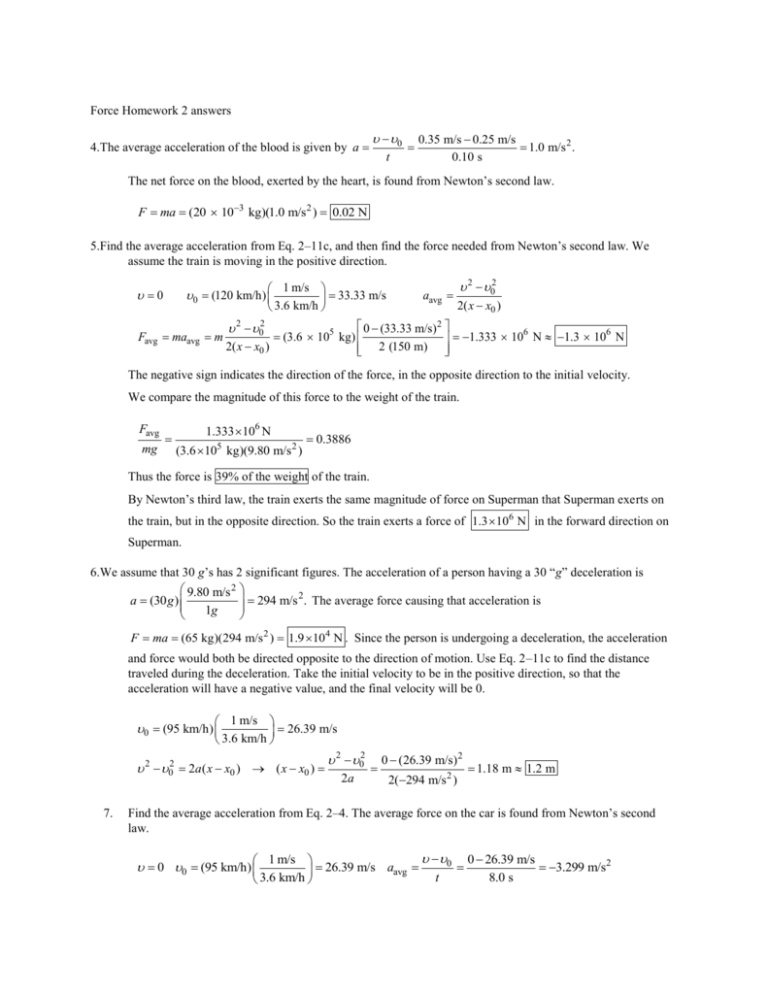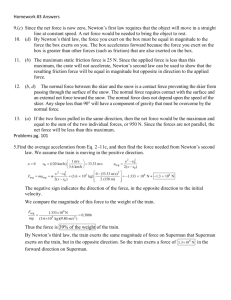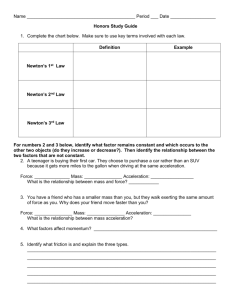Force homweork 2 answers
advertisement

Force Homework 2 answers 4.The average acceleration of the blood is given by a 0 t 0.35 m/s 0.25 m/s 1.0 m/s 2 . 0.10 s The net force on the blood, exerted by the heart, is found from Newton’s second law. F ma (20 103 kg)(1.0 m/s2 ) 0.02 N 5.Find the average acceleration from Eq. 2–11c, and then find the force needed from Newton’s second law. We assume the train is moving in the positive direction. 2 02 1 m/s 0 (120 km/h) 33.33 m/s a avg 2( x x0 ) 3.6 km/h 0 (33.33 m/s) 2 2 02 6 6 maavg m (3.6 105 kg) 1.333 10 N 1.3 10 N 2( x x0 ) 2 (150 m) 0 Favg The negative sign indicates the direction of the force, in the opposite direction to the initial velocity. We compare the magnitude of this force to the weight of the train. Favg mg 1.333 106 N (3.6 105 kg)(9.80 m/s 2 ) 0.3886 Thus the force is 39% of the weight of the train. By Newton’s third law, the train exerts the same magnitude of force on Superman that Superman exerts on the train, but in the opposite direction. So the train exerts a force of 1.3 106 N in the forward direction on Superman. 6.We assume that 30 g’s has 2 significant figures. The acceleration of a person having a 30 “g” deceleration is 9.80 m/s 2 2 a (30 g ) 294 m/s . The average force causing that acceleration is 1 g F ma (65 kg)(294 m/s 2 ) 1.9 104 N . Since the person is undergoing a deceleration, the acceleration and force would both be directed opposite to the direction of motion. Use Eq. 2–11c to find the distance traveled during the deceleration. Take the initial velocity to be in the positive direction, so that the acceleration will have a negative value, and the final velocity will be 0. 1 m/s 26.39 m/s 3.6 km/h 0 (95 km/h) 2 02 2a( x x0 ) ( x x0 ) 7. 2 02 2a 0 (26.39 m/s) 2 2(294 m/s 2 ) 1.18 m 1.2 m Find the average acceleration from Eq. 2–4. The average force on the car is found from Newton’s second law. 0 0 26.39 m/s 1 m/s 3.299 m/s2 26.39 m/s aavg 3.6 km/h t 8.0 s 0 0 (95 km/h) Favg maavg (950 kg)(3.299 m/s2 ) 3134 N 3100 N The negative sign indicates the direction of the force, in the opposite direction to the initial velocity. 8. Find the average acceleration from Eq. 2–11c, and then find the force needed from Newton’s second law. aavg 2 02 2( x x0 ) Favg maavg m 9. (13 m/s) 2 0 (7.0 kg) 211.25 N 210 N 2( x x0 ) 2 (2.8 m) 2 02 The problem asks for the average force on the glove, which in a direct calculation would require knowledge about the mass of the glove and the acceleration of the glove. But no information about the glove is given. By Newton’s third law, the force exerted by the ball on the glove is equal and opposite to the force exerted by the glove on the ball. So we calculate the average force on the ball, and then take the opposite of that result to find the average force on the glove. The average force on the ball is its mass times its average acceleration. Use Eq. 2–11c to find the acceleration of the ball, with 0, 0 35.0 m/s, and x x0 0.110 m. The initial velocity of the ball is the positive direction. aavg 2 02 2( x x0 ) 0 (35.0 m/s)2 5568m/s2 2(0.110 m) Favg maavg (0.140 kg)(5568 m/s2 ) 7.80 102 N Thus the average force on the glove was 780 N, in the direction of the initial velocity of the ball. 10. Choose up to be the positive direction. Write Newton’s second law for the vertical direction, and solve for the tension force. F FT mg ma FT m( g a ) mg FT (1200 kg)(9.80 m/s 0.70 m/s ) 1.3 10 N 2 2 FT 4




